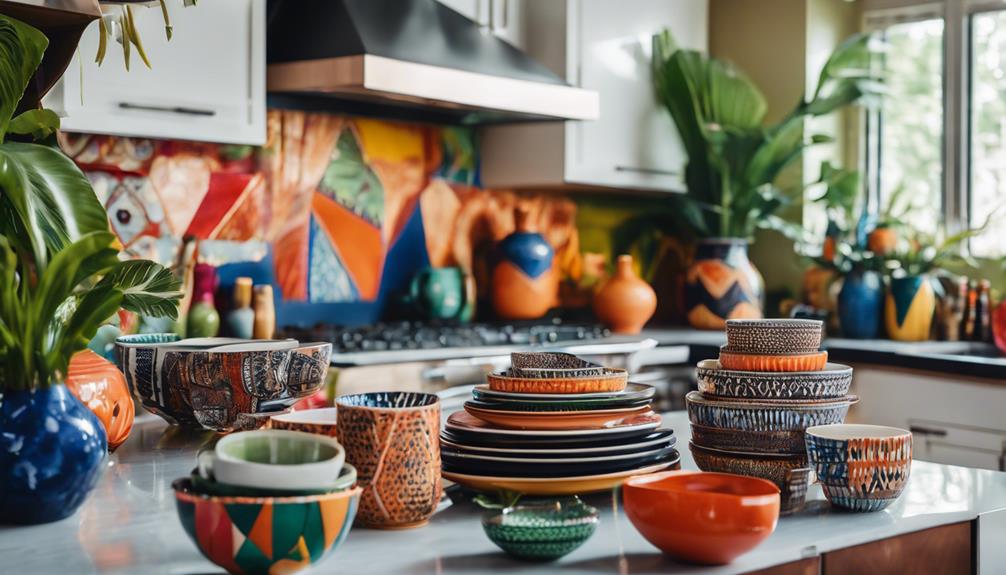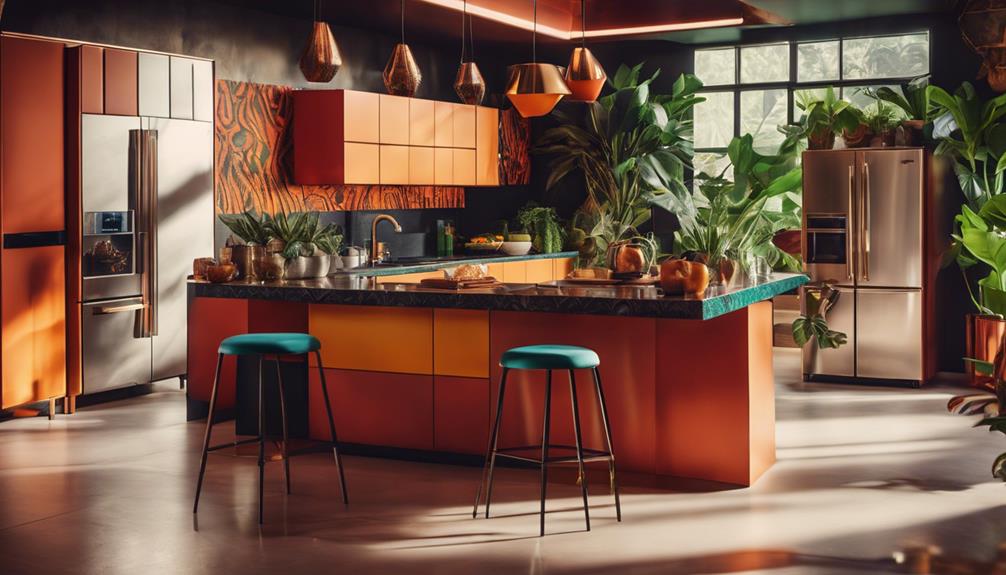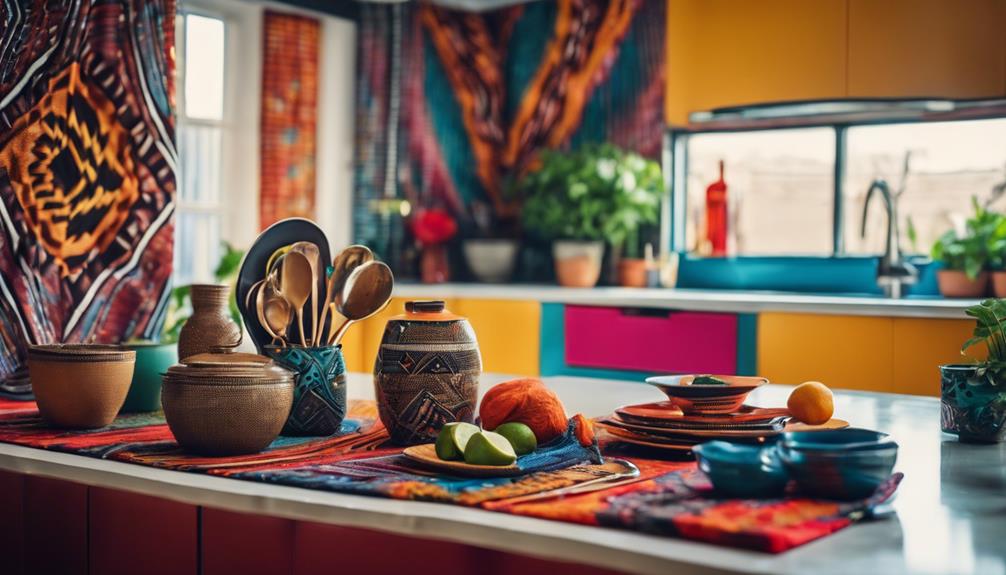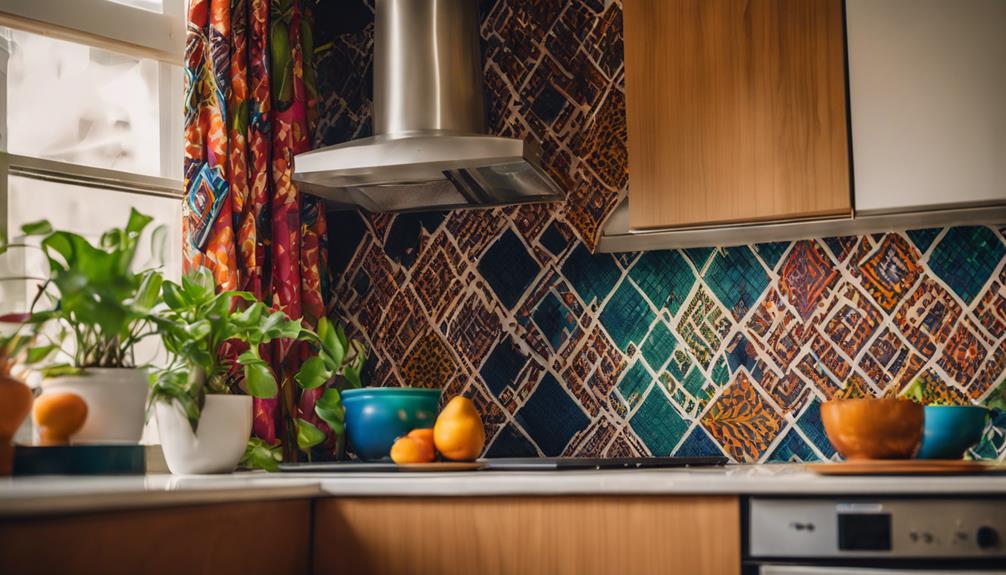You can easily turn your kitchen into an Afrofuturistic oasis without a major renovation. Begin by adding bold colors such as deep reds and sunny yellows through accessories or a Kente cloth table runner. Incorporate unique textures with vibrant African textiles and elegant natural materials like reclaimed wood. Improve lighting with neon Afrocentric wall sconces or whimsical LED strip lights to create a welcoming atmosphere. Lastly, include decorative elements like metallic tribal sculptures or colorful beaded wall art to honor cultural heritage. There are plenty of ways to enhance your kitchen’s ambiance, so continue exploring new ideas!
Key Elements

When you think about key elements in your Afrofuturistic kitchen, consider the color scheme, materials, and textures that reflect both heritage and innovation.
Bold colors can energize your space, while unique materials and varied textures add depth and interest.
Color Scheme
Embrace a vibrant color scheme in your kitchen by incorporating bold hues like deep reds, bright yellows, and rich greens inspired by African textiles. These colors can energize the space and create an inviting atmosphere.
Use accent walls or decorative elements in earthy browns and sunset oranges to evoke the warmth of African landscapes. For added personality, choose accessories like dishware, textiles, and artwork that reflect African cultural motifs and patterns. These design ideas not only add depth but also celebrate the richness of African heritage.
Don't forget to incorporate metallic accents like gold or bronze. These elements evoke a futuristic feel while beautifully complementing the rich colors of Afrofuturism.
Experimenting with a mix of matte and glossy finishes can also enhance visual interest, making your kitchen a contemporary masterpiece.
Materials
Incorporating vibrant African textiles like Kente cloth or Mudcloth can instantly elevate your kitchen's aesthetic by introducing bold colors and patterns. You can use these textiles as table runners or wall hangings to create a striking visual impact that ties into your existing kitchen design concepts.
Consider natural materials, such as reclaimed wood, for open shelving or countertops. This choice not only reflects sustainability but also adds warmth and character to your space.
To evoke a futuristic aesthetic, integrate metallic accents like brass or chrome in cabinet handles and light fixtures. These elements can seamlessly blend with traditional design features while enhancing the overall look.
Eco-friendly materials, like bamboo, work well for kitchen utensils and storage solutions, promoting an organic feel. Additionally, selecting bold, artistic dishware and cookware from Black artisans allows you to celebrate Afrocentric culture while boosting the visual interest of your kitchen decor.
Textures
Textures play an essential role in creating an inviting and dynamic Afrofuturistic kitchen, where each element contributes to a rich sensory experience.
To enhance your kitchen look, consider incorporating vibrant African textiles like Kente cloth or Mudcloth as table runners or wall hangings. These fabrics not only add rich color but also introduce unique textures that can make the space feel more alive.
Natural materials such as wood and stone can serve as countertops or decor, fostering a tactile connection to nature. This earthy aesthetic aligns beautifully with Afrofuturism, grounding your design in tradition while looking forward.
Decorative accents like woven baskets or pottery bring warmth and cultural significance, enriching your kitchen environment.
Don't forget to layer different textures with rugs, cushions, or decorative towels featuring bold patterns and colors. This layering infuses energy and visual interest into the space.
Essential Fixtures and Furniture

When selecting essential fixtures and furniture for your Afrofuturistic kitchen, think about incorporating a vintage African-inspired sink that serves as a unique focal point.
Geometric-patterned bar stools can add a modern touch while celebrating African aesthetics.
Don't forget an African-inspired pendant light to enhance the atmosphere with a blend of tradition and innovation.
Vintage African-Inspired Sink
A vintage African-inspired sink can transform your kitchen into a vibrant space that showcases cultural heritage while offering practical functionality. These sinks often feature intricate patterns and craftsmanship that reflect traditional African artistry, making them a striking focal point.
When selecting a vintage sink, look for materials like handmade ceramic or brass, which not only evoke historical techniques but also bring warmth and character to your kitchen. Consider choosing a sink with bold colors or unique designs that incorporate motifs from various African cultures. This adds an Afrofuturistic aesthetic to your space while keeping it lively and inviting.
Pair your vintage sink with contemporary fixtures in metallic finishes to create an appealing blend of old and new, highlighting both heritage and modernity. To enhance the eco-friendly aspect of your kitchen, opt for sinks made from reclaimed or sustainably sourced materials.
Doing so honors the principles of Afrofuturism, which advocate for sustainability and community connection. A vintage African-inspired sink not only elevates your kitchen's design but also supports your meal prep, ensuring that you can cook and create in a space that resonates with beauty and purpose.
Geometric-Patterned Bar Stools
How can geometric-patterned bar stools elevate your kitchen's design while celebrating Afrofuturistic aesthetics? These vibrant stools add dynamic visual interest, reflecting bold colors and patterns that are essential to Afrofuturism. By choosing bar stools made from sustainable materials featuring African-inspired designs like Kente cloth or Mudcloth, you honor cultural heritage while enhancing your kitchen decor.
Incorporating geometric designs not only serves as a stylish accent but also evokes modernity and futurism, perfectly aligning with an Afrofuturistic vibe. Opt for stools with metallic accents, such as chrome or brass finishes, to further infuse a futuristic element into your space.
When selecting your geometric-patterned bar stools, prioritize ergonomic designs to guarantee comfort and functionality. This way, they become practical for everyday use, especially in busy kitchens where you may have to put away items quickly.
With these stools, you'll create inviting counter space that encourages social interaction and creativity, making your kitchen not just a cooking area but a vibrant gathering place. Embrace the fusion of style and culture with geometric-patterned bar stools that elevate your kitchen's design.
African-Inspired Pendant Light
Incorporating African-inspired pendant lights transforms your kitchen into a vibrant focal point, seamlessly blending traditional craftsmanship with modern design.
These fixtures not only illuminate your space but also reflect Afrofuturism, creating a unique ambiance that celebrates African culture. When you choose pendant lights made from materials like woven rattan or metal, you introduce intricate patterns and vibrant colors that can truly make your kitchen stand out.
Adjustable pendant heights are a great feature to evaluate; they enable you to tailor the lighting to various kitchen tasks while maintaining an eye-catching design element.
This adaptability is especially useful if you're working with a temporary kitchen or limited space.
Lighting Ideas

When it comes to lighting, you can truly elevate your kitchen with unique Afrofuturistic options.
Think about adding neon Afrocentric wall sconces or LED fiber optic ceiling lights that create a vibrant atmosphere.
With choices like holographic LED table lamps and dynamic strip lighting, you can merge art and functionality seamlessly.
Neon Afrocentric Wall Sconces
Neon Afrocentric wall sconces transform your kitchen into a vibrant space, showcasing bold colors and unique designs that celebrate African heritage while embracing contemporary style.
These sconces serve as striking focal points, drawing attention with their geometric patterns and motifs inspired by traditional African art. This cultural richness enhances your kitchen without requiring a full remodel.
Incorporating LED technology into these sconces boosts energy efficiency and offers customizable lighting options, allowing you to create different moods for cooking and entertaining. Whether you want warm, inviting light for family dinners or bright, focused lighting for meal prep, these sconces can do it all.
You can achieve a futuristic yet culturally resonant look by choosing sconces that blend Afrocentric designs with modern materials like acrylic or chrome.
Positioning them strategically above countertops or dining areas not only highlights specific zones but also adds a functional element to your kitchen decor.
Neon Afrocentric wall sconces elevate your space, merging aesthetics with practicality, and making your kitchen a true reflection of your unique style.
LED Fiber Optic Ceiling Lights
Building on the vibrant energy of neon Afrocentric wall sconces, LED fiber optic ceiling lights can elevate your kitchen's atmosphere with customizable colors and patterns that reflect your personal style and the essence of Afrofuturism. These lights create a dynamic and futuristic ambiance, enabling you to transform your space into an enchanting environment.
One of the best aspects of LED fiber optic lights is their energy efficiency. Compared to traditional lighting, they consume less power, aligning perfectly with sustainable design principles. Plus, the fiber optic technology offers a soft and even distribution of light, minimizing harsh shadows and enhancing your kitchen's overall mood.
Installation is a breeze, making it a great DIY project that can save you money while adding a modern touch. With the versatility of fiber optic lighting, you can design stunning features like starry night ceilings or vibrant light displays, seamlessly incorporating them into your Afrofuturistic kitchen aesthetic.
Afrofuturistic LED Strip Lighting
Incorporating Afrofuturistic LED strip lighting can transform your kitchen into a vibrant space that not only enhances functionality but also celebrates cultural heritage.
Using LED strips in bold colors reflects the bright aesthetic of Afrofuturism while providing essential illumination. You can install them under cabinets or along shelves to accentuate Afrocentric art pieces or African textiles, creating stunning focal points that honor Black culture.
Consider programmable LED strips to craft dynamic lighting scenes that shift colors according to your mood or events. This adds a futuristic flair to your kitchen, allowing you to tailor the ambiance for dinners, gatherings, or quiet evenings.
Opt for energy-efficient LED strips to reduce your electricity usage, aligning with the sustainability values often found in Afrofuturist design.
Additionally, smart technology options let you control your lighting remotely, merging modern convenience with a design that embraces both heritage and innovation.
With these elements, you can elevate your kitchen to a space that not only serves culinary purposes but also tells a story through light, culture, and technology.
Holographic LED Table Lamps
Holographic LED table lamps can elevate your kitchen's aesthetic, adding a touch of futuristic flair while showcasing the vibrant spirit of Afrofuturism. These innovative lamps create dynamic light displays that change colors and patterns, instantly transforming your space.
With energy-efficient LED bulbs, you'll not only save on your electricity bill but also enjoy a longer lifespan compared to traditional bulbs, making them a smart, sustainable choice for your kitchen.
Adjustable brightness and color settings allow you to customize the ambiance for any occasion, whether you're whipping up a casual meal or hosting an elegant dinner. Incorporating holographic LED table lamps into your design enhances your Afrofuturistic theme, seamlessly blending elements of technology and art that reflect cultural heritage and modern innovation.
Plus, these unique lamps serve as conversation starters, showcasing creativity and functionality. They celebrate the expressive nature of Afrofuturism in everyday life, inviting your guests to engage with the aesthetic.
Decorative Elements

You can easily elevate your kitchen's aesthetic by incorporating a vibrant Kente cloth table runner that adds both color and cultural significance.
Consider showcasing metallic African tribal sculptures and colorful beaded wall art to create striking focal points that celebrate heritage.
These decorative elements not only reflect your style but also infuse your space with Afrofuturistic flair.
Kente Cloth Table Runner
A Kente cloth table runner brings vibrant colors and rich cultural storytelling to your kitchen or dining space. Originating from the Ashanti people of Ghana, this stunning textile features intricate patterns that symbolize cultural heritage and artistry. By incorporating a Kente cloth table runner, you not only add a bold pop of color but also celebrate Black culture in a meaningful way.
This lightweight and durable fabric is perfect for everyday use, making it a practical addition to your decor. Its unique designs can spark conversations during gatherings, allowing you to share the stories behind the patterns. You can easily pair the runner with other decor elements, such as Afrocentric art or modern tableware, to create a cohesive and dynamic aesthetic that reflects your personal style.
Using a Kente cloth table runner is an affordable way to infuse Afrofuturistic elements into your kitchen without the need for a full remodel. It enhances both the style and cultural significance of your space, transforming your dining experience into something extraordinary.
Metallic African Tribal Sculptures
Integrating metallic African tribal sculptures into your kitchen decor not only enhances the visual appeal but also celebrates the rich heritage and craftsmanship of African artistry. These striking decorative elements bring a contemporary flair while honoring traditional craftsmanship.
Crafted from materials like brass, bronze, or aluminum, their intricate designs resonate with Afrofuturistic themes, creating a mesmerizing blend of old and new.
You can strategically place these sculptures on open shelves or countertops. Doing so not only provides artistic focal points but also sparks conversations about their cultural significance, reflecting your appreciation for diverse artistic traditions.
The reflective quality of the metals can enhance your kitchen's lighting, adding depth and visual interest to the space.
Colorful African Beaded Wall Art
Colorful African beaded wall art transforms your kitchen into a vibrant space, showcasing intricate patterns and rich cultural heritage. When you incorporate these striking pieces, you create a focal point that not only enhances the visual appeal but also adds a unique blend of cultural significance and modern flair.
Each beaded artwork is typically handmade, reflecting the craftsmanship of talented artisans. This authenticity connects your kitchen to the broader Afrofuturist aesthetic, celebrating the beauty of African culture. By displaying these pieces, you foster an environment that inspires creativity and joy, making your cooking space more inviting.
These vibrant hues and intricate designs can uplift the atmosphere, encouraging a deeper appreciation for the rich histories and traditions they represent. As you cook, the beaded art serves as a constant reminder of the vibrant cultures that have shaped our world.
Flooring

When it comes to flooring in your Afrofuturistic kitchen, consider the unique warmth of reclaimed African hardwood planks for a rich, organic feel.
You might also explore textured African mud cloth tiles that add a striking visual element while celebrating cultural heritage.
Eco-friendly bamboo flooring is another great option, combining sustainability with modern aesthetics to create a dynamic space.
Reclaimed African Hardwood Planks
Reclaimed African hardwood planks like Teak, Mahogany, and Iroko not only elevate your kitchen's aesthetic but also bring a rich cultural heritage that resonates with the Afrofuturistic theme. These woods are durable and offer unique grain patterns and rich colors, adding warmth and character to your space.
By choosing reclaimed wood, you're also making a sustainable choice that minimizes the need for new lumber, reducing your environmental impact. When properly maintained, reclaimed hardwood flooring can last for generations. This longevity aligns perfectly with the Afrofuturism ethos, emphasizing sustainability and timelessness.
Imagine walking into a kitchen that not only looks stunning but also tells a story through its flooring. The connection between the indoors and outdoors becomes seamless, evoking a sense of nature and tranquility.
Integrating reclaimed African hardwood planks into your kitchen isn't just about aesthetics; it's about celebrating Black culture and craftsmanship. You'll create a focal point that captivates and inspires, inviting conversations and admiration.
Textured African Mud Cloth Tiles
Textured African Mud Cloth tiles bring a vibrant and unique flair to your kitchen flooring, celebrating cultural heritage while enhancing visual interest. Made from traditional handwoven fabric, these tiles feature rich patterns and colors that evoke a sense of identity and creativity.
When you incorporate Mud Cloth tiles into your kitchen, you're not just adding style; you're also embracing a piece of African culture. These tiles are incredibly durable and easy to clean, making them a practical choice for high-traffic kitchen areas. Their unique textures create a striking contrast with modern kitchen elements, allowing you to blend traditional craftsmanship with contemporary design effortlessly.
Imagine walking on flooring that tells a story, each step reflecting a rich cultural history. Incorporating Mud Cloth tiles invites a sense of warmth and depth into your kitchen, transforming it into a storytelling space. You'll create an environment that resonates with your values and aesthetic preferences, showcasing your appreciation for Afrofuturism.
Eco-friendly Bamboo Flooring
Building on the cultural richness of textured African Mud Cloth tiles, eco-friendly bamboo flooring offers a sustainable and stylish alternative that enhances your kitchen's aesthetic while prioritizing environmental health.
Unlike traditional hardwood, bamboo is made from a fast-growing grass that can be harvested every 3-5 years, making it a renewable resource that won't harm the ecosystem.
You'll appreciate bamboo's durability and strength, especially in high-traffic areas like kitchens where wear and tear are common. With an array of styles, colors, and finishes available, you can effortlessly integrate bamboo flooring into your Afrofuturistic design—celebrating bold and vibrant elements that reflect your unique taste.
Moreover, bamboo flooring has a low environmental impact, requiring less energy for production compared to conventional hardwood. This choice not only supports a more sustainable home but also contributes to a healthier planet.
Additionally, bamboo's natural antimicrobial properties make it a hygienic option for your kitchen, ensuring a clean and safe cooking environment.
How Can I Add Afrofuturistic Elements to My Kitchen Without Renovating?
Bring some whimsical cottagecore kitchen decor ideas into your space to add Afrofuturistic elements without renovating. Incorporate vibrant textiles, cultural artwork, and futuristic gadgets seamlessly into your existing decor. Try adding Afrofuturistic patterns and shapes to your tableware or hang eclectic artwork for a unique, eclectic look.
Conclusion
By incorporating Afrofuturistic elements into your kitchen, you can create a vibrant and inspiring space without a full remodel.
Focus on key fixtures, choose unique lighting, and add decorative elements that reflect rich cultural heritage.
With the right flooring and furniture, you'll infuse your kitchen with a sense of innovation and tradition.
Embrace these ideas to transform your cooking area into a haven of creativity and connection, celebrating the beauty of Afrofuturism every day.









